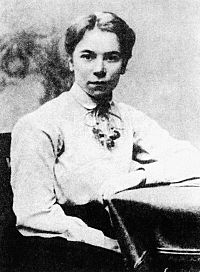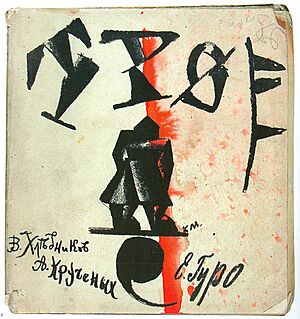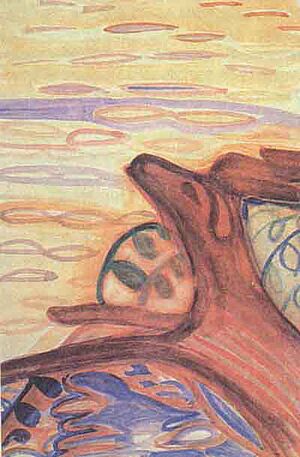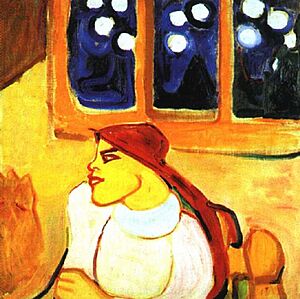Elena Guro facts for kids
Quick facts for kids
Elena Guro
|
|
|---|---|

Elena Guro c. 1900
|
|
| Born | January 10, 1877 |
| Died | May 6, 1913 (aged 36) Uusikirkko
|
| Known for | The Hurdy-Gurdy Autumnal Dream Finland |
| Movement | Futurism Cubo-Futurism |
Elena Guro (born January 10, 1877 – died May 6, 1913) was a talented Russian artist. She was a painter, a writer of plays, poems, and stories. Elena Guro was part of an art movement called Futurism. This movement focused on new ideas and the future.
She is known for creating new ideas about how to use color in her paintings. Elena Guro was also the only woman in a very important Futurist group called Cubo-Futurism.
Contents
Early Life
Elena Guro was born in Saint Petersburg, Russia, on January 10, 1877. Her father, Genrikh Stepanovich Guro, was an army officer. Her mother, Anna Mikhailovna Chistyakova, was also an artist.
Elena spent her childhood in the countryside, in a village near Pskov. She also lived at her father's estate in Luga. From her father, she received money and property in Finland. This helped her to follow her dreams as an artist. Her sister, Ekaterina Guro, was also a writer.
Her Artistic Journey
From 1890 to 1893, Elena studied art in St. Petersburg. Later, from 1903 to 1905, she studied in a private art studio. There, she met Mikhail Matyushin, who later became her husband in 1906.
In 1905, Elena Guro's first short story, Early Spring, was published. It appeared in a collection of works by young Russian writers. A year before that, in 1904, she drew pictures for a Russian version of fairy tales by the French writer George Sand.
In 1906, Elena and Mikhail moved to another art school. There, she learned from famous artists like Mstislav Dobuzhinsky and Léon Bakst. By 1908, she opened her own art studio. Her home became a popular place for artists and writers to meet and talk about their ideas.
Her first book, The Hurdy-Gurdy, came out in 1909. It included stories, poems, and plays. In 1910, she wrote for Trap for Judges, one of the first magazines by Russian Futurists. She also contributed to its second issue in 1913. Elena and her husband helped pay for both issues of the magazine.
In 1911, Elena Guro had a book of fairy tales ready to be published. Sadly, the publisher lost her manuscript and all her drawings for it. Her second book, Autumnal Dream, was published in 1912.
Elena Guro was very interested in how cities and nature were different. She wrote stories about how living in a city affected people. She was known for describing Russian cities very clearly in her poems. But around 1910, she started to prefer the countryside. Her husband said she would stay there from spring to autumn.
In her paintings, Elena Guro explored how colors work together. This interest began in 1911 and became a key part of her art. She developed ideas about color based on Art Nouveau and folk art from Scandinavia. After she passed away, her husband used her color theories in his own work.
Last Days
In 1913, Elena Guro continued to write and paint. She was battling a serious illness called leukemia. She passed away that same year at her country house in Uusikirkko, which was then part of Finland.
When she died, she was almost finished with a big work called The Poor Knight. Some of her poems and stories were published after her death. These appeared in a collection called The Three and in a magazine called Union of Youth. Her third book, The Little Camels of the Sky, was published in 1914.
Her Unique Art Style
Elena Guro's art combined painting, poetry, and stories. She saw life in an impressionistic way, focusing on feelings and moments. Her writing was often short and lyrical. She often wrote about motherhood and a deep connection to nature.
Interest in Elena Guro's work grew after Vladimir Markov's book "Russian Futurism" came out in 1968. In 1988, a collection of her works was published in Stockholm. In 1995, more of her unpublished writings were found and published. Many studies have been done on her creative work in Russia and other countries.
Her Books

- The Hurdy-Gurdy (1909)
- Autumnal Dream (1912)
- The Poor Knight (1913)
- The Little Camels of the Sky (1914)
- The Three (1913) (published after her death); this book contains her most famous poem, Finland.
English Translations
- The Little Camels of the Sky, found in The Ardis Anthology of Russian Futurism, 1983.
- Thus Life Passes, found in 50 Writers: An Anthology of 20th Century Russian Short Stories, 2011.
See also
 In Spanish: Yelena Guró para niños
In Spanish: Yelena Guró para niños




